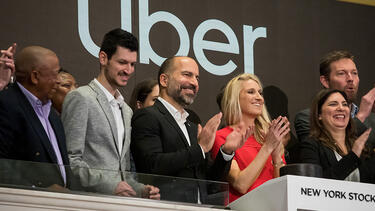Don’t Be Surprised by Uber’s Low-Priced IPO—It’s a Sign of Challenges to Come
Like its competitor Lyft, the ridesharing service Uber has entered the public markets with a thud, sliding from an already-low IPO price. According to Yale SOM’s Matthew Spiegel and Heather Tookes, an IPO is often followed by disappointing returns, not just for the newly public company but its entire industry.

Uber CEO Dara Khosrowshahi, center, at the New York Stock Exchange during the company’s IPO on Friday, May 10. Photo: Michael Nagle/Bloomberg via Getty Images.
This commentary originally appeared in Fortune.
The newly public shares of Lyft have failed to deliver the sustained liftoff for which many investors have hoped. And rival Uber has priced its highly anticipated IPO at $45, the low end of the price range that it set two weeks ago. In financial statements, released last month, Uber revealed slowing growth and operating losses ahead of its offering. Should investors be surprised? Not in the least. In fact, this should serve as a useful reminder to small investors hoping to purchase IPO firms’ shares after they start trading in public markets of an important fact: The average IPO underperforms otherwise similar stocks by 7% to 8% in the three years following the offering.
Consider Blue Apron. When it launched its IPO on June 29, 2017, it was one of the leaders in the fast-growing meal kit delivery industry. The IPO was priced at $10 and closed at $9.34 on the next full day of trading. Today, the stock trades at around $1. HelloFresh went public later the same year and, while its debut was more successful than Blue Apron’s, Hello Fresh’s stock price has also slumped post IPO. What could explain these disappointing returns? Amazon’s acquisition of Whole Foods two months after the Blue Apron IPO certainly contributed to investors’ deteriorating expectations about the future of meal kit delivery. The availability of meal kits in local grocery stores and customers’ willingness to try these new offerings are also likely culprits. In other words, the IPOs of Blue Apron and HelloFresh occurred just as the overall meal kit industry was becoming more competitive.
The lackluster performance of IPOs should be sobering but there is a bigger story that looms in the background: On average, entire industries see their values and profitability decline following the typical IPO. A 2010 study published in the Journal of Finance found that already-public firms experience negative stock returns during the weeks surrounding rivals’ IPOs. These firms also saw a 3.3% decline in sales growth and a 2.9% reduction in profitability during each of the three years following an IPO in the industry.
One possibility for this decline in industry values is that public financing makes IPO firms stronger at the expense of rivals. This idea, however, is not supported by the data. In fact, our own calculations indicate that when firms go public, they are typically very small with market shares below 1%. And they remain small, with most seeing less than a 1% change in their market shares in subsequent years. Moreover, the fact that sluggish growth continues in the long run suggests that there is more to the story.
A second, more plausible, explanation for weak industry performance post-IPO is market timing, where IPO firms’ managers choose to conduct IPOs when investors are paying unusually high prices for similar stocks (for example, the wave of technology IPOs during the late 1990s). Indeed, firms issue stock when valuations are high, which can benefit IPO firms but not new investors.
In addition to market timing, there are fundamental shifts occurring in the industries in which firms go public. In our own research, we have found that industry performance declines because IPOs tend to occur when once-loyal customers become easier to steal. This reduces overall profitability and suggests that an IPO is a forewarning of significant changes to come in the industry. Take GoPro, the wearable camera company that went public on June 26, 2014. Its stock traded at $31.34 at the close of its first day of trading, and while it increased during the months following the IPO, it now trades at around $6.15. Why the steep drop? Just look at your smartphone. Its rapidly improving photo-taking capabilities since the GoPro IPO—along with the availability of waterproof and shockproof cases—are some likely contributors. The entire camera industry is simply more competitive.
There are certainly counter-examples where the values and profits of both the IPO firms and their industries continued to rise for years following new public offerings (think Google, Mastercard, and Visa). But the general evidence demonstrating that IPOs tend to foreshadow increased competition and a deterioration in both IPO firms’ and their rivals’ performance should, at the very least, temper the excitement of any company’s post-IPO flight.